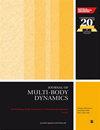An effective modelling approach for multi-body dynamic analysis of epicyclic gear train of GTF considering both structural flexibility and mechanical interactions
IF 1.9
4区 工程技术
Q3 ENGINEERING, MECHANICAL
Proceedings of the Institution of Mechanical Engineers Part K-Journal of Multi-Body Dynamics
Pub Date : 2023-10-09
DOI:10.1177/14644193231203592
引用次数: 0
Abstract
In this paper, a new modelling approach is proposed for the dynamic investigation of epicyclic gear train, and the novelty of this work lies in consideration of both structural flexibility and mechanical interactions during the analysis procedure. The method is of capacity to directly present the dynamic results of the supporting structure for convenient practical engineering evaluation and reduce the dimension of the system reasonably with appropriate assumptions for better computational efficiency. Firstly, the mechanical interactions among components are discussed in detail, and the principle that the structural flexibility works is also explained at length. Secondly, taking the epicyclic gear train of the geared turbofan (GTF) engine; for example, the dynamic model of the system is then established based on the developed hybrid user-defined elements. For model validation, the governing equations of the system are also derived by the lumped mass method. Thirdly, with the same values of the parameters, the results of normal dynamic meshing force obtained by the proposed model are compared with the ones by the lumped mass model. It can be stated from the data that (1) the maximum relative error between the theoretical value and the average value calculated by the two models is 8.28%, (2) the gear mesh frequency obtained by the two models are sufficiently close to the theoretical value, and (3) the fluctuation trends of the dynamic force keep basically consistent with each other. In summary, the comparison presented clearly indicates that the proposed model is indeed reasonable, which provides a new way for dynamic investigation and structural redesign of a large epicyclic gear train. Finally, as a practical engineering application, the vibration result of the deformable supporting structure of the GTF gear train is also presented, which directly provides valuable reference for vibration monitoring, fault diagnosis and other engineering problems in practice.一种考虑结构柔性和力学相互作用的GTF行星轮系多体动力学分析的有效建模方法
本文提出了一种用于行星轮系动力学研究的新建模方法,其新颖之处在于在分析过程中同时考虑了结构柔性和力学相互作用。该方法能够直接表示支护结构的动态结果,方便实际工程评估,并在适当的假设条件下合理降低系统维数,提高计算效率。首先,详细讨论了构件间的力学相互作用,并对结构柔性的工作原理进行了阐述。其次,以齿轮传动涡扇(GTF)发动机的行星轮系为例;例如,基于开发的混合用户定义元素,建立了系统的动态模型。为了验证模型,采用集中质量法推导了系统的控制方程。第三,在参数相同的情况下,将该模型与集总质量模型的法向动态啮合力计算结果进行比较。从数据可以看出:(1)两种模型计算的理论值与平均值的最大相对误差为8.28%,(2)两种模型得到的齿轮啮合频率与理论值足够接近,(3)动力的波动趋势基本一致。结果表明,所提出的模型是合理的,为大型周转轮系的动力学研究和结构设计提供了新的途径。最后,作为实际工程应用,给出了GTF轮系变形支承结构的振动结果,直接为实际中的振动监测、故障诊断等工程问题提供了有价值的参考。
本文章由计算机程序翻译,如有差异,请以英文原文为准。
求助全文
约1分钟内获得全文
求助全文
来源期刊

CiteScore
4.10
自引率
11.10%
发文量
38
审稿时长
>12 weeks
期刊介绍:
The Journal of Multi-body Dynamics is a multi-disciplinary forum covering all aspects of mechanical design and dynamic analysis of multi-body systems. It is essential reading for academic and industrial research and development departments active in the mechanical design, monitoring and dynamic analysis of multi-body systems.
 求助内容:
求助内容: 应助结果提醒方式:
应助结果提醒方式:


